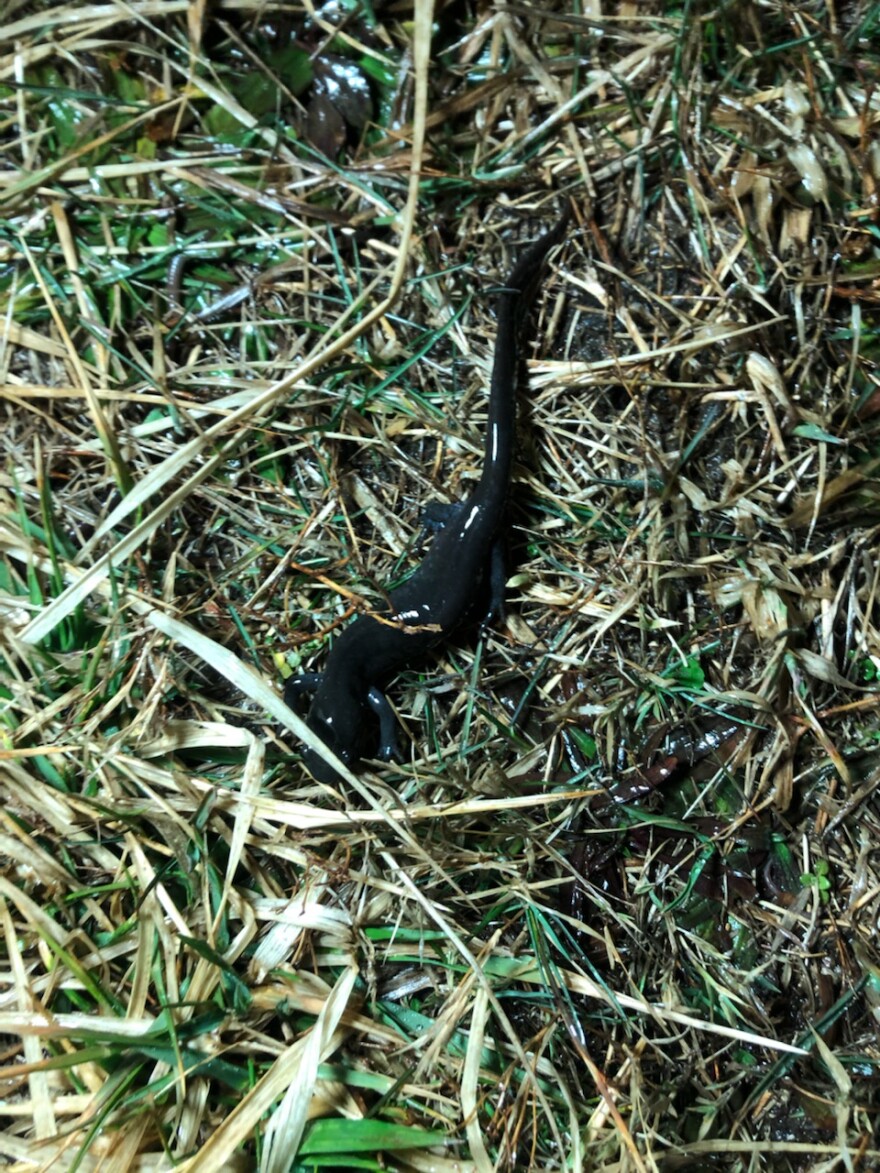During the first warm rains of early spring, the cold-blooded yellow spotted salamander (Ambystoma maculatum) emerges from its underground burrow to migrate to something called a vernal pool.
Vernal pools are seasonal bodies of water that act as breeding ponds for a number of amphibious animals. Since they dry up in the summer and fall, most predators of amphibious animals, like the spotted salamander, can’t survive in them.

The vernal pool at Caesar Creek is surrounded by forest. That’s where the spotted salamander spends most of its time—over ninety percent of its life—burrowed underground or hiding in logs, underneath rocks and in piles of wet leaves. The yellow spotted salamander is a part of the mole salamander family.
But for a few nights every spring, when the conditions are just right, the salamander makes its move.
After it gets dark, hundreds of salamanders appear. The salamanders, which range in length from six to nine inches, scurry across the grass, and sneak through underground burrows.

Some will travel as far as a mile. It can be a treacherous journey. Sometimes they have to cross roads. Raccoons and opossums will pick some of them off before they reach the vernal pool—even though the spotted salamander can secrete a mildly toxic poison.
The male salamanders get to the pool first. They attach their spermatozoa to sticks and plants underwater. Then, the female salamanders arrive—they are noticeably bigger than the males because they are laden with hundreds of eggs. The females take up the sperm packets, fertilizing their eggs, and then they lay the eggs in clusters.

A special algae called Oophila amblystomatis (which means "loves salamander eggs" in Latin) forms inside the eggs. The algae and salamander embryos have a symbiotic relationship—meaning both of the organisms benefit. The algae consumes carbon dioxide put off by the eggs and the algae provides the embryo with oxygen.
The eggs take four or five months to hatch. After they hatch, the tiny salamanders will move to the forest and won't return to the vernal pool until they are old enough to reproduce a few years later. The yellow spotted salamander can live for up to thirty years.
Coming to see the salamanders has become an annual tradition for Ohio Certified Volunteer Naturalist Rick Kniesel. His email address starts with "salarick."
“I'm 70 and have probably come and seen the salamander migrations about 40 years in a row," he said. "I missed only one when I had a hip replacement.”
It was the second time this season Kniesel had come out to see the migration. The first time, in late February, he said the conditions were perfect so there was a big run. But he was impressed that there were still a lot of salamanders out that night.
"That means the population of salamanders in this area is fantastic," he said.
He said it's possible there was a bit of a traffic jam going on that night. Some of the salamanders were returning to the woods and they passed by the others who were coming to the pool for the first time.
The yellow spotted salamander wasn't the only species out that night. The Jefferson salamander, which is also a part of the mole salamander family, was migrating as well.

Caitlin Messerschmitt and her daughter Calliope came all the way from Cincinnati to see the salamanders.
Caitlin caught the salamander bug when she worked at a nearby camp that had a vernal pool on the property.
"Every night it was right there," she said. "That's where I really fell in love."
And now she's passed that love on to her daughter.

There is an almost deafening cacophony of sound in the background that gets louder as it gets darker. It's the mating calls of American wood frogs (Lithobates sylvaticus) and northern spring peepers (Pseudacris crucifer).

Kniesel calls it the harbinger of spring. In a few months, it will sound completely different. Then it will be the mating season for different amphibians like bullfrogs and chorus frogs
Calliope picks up one of the peepers up and gently held it in her hand.
“We found another frog,” she said.
Environmental reporter Chris Welter is a corps member with Report for America, a national service program that places journalists into local newsrooms.


